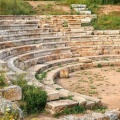TOP-10 sights of the world, which have analogues in Crimea. Part 2
 Crimea is able to surprise every day even those who live here or come here every vacation. Especially if you take the fact that in order to see foreign resorts, it is not necessary to apply for a visa and fly far away.
Crimea is able to surprise every day even those who live here or come here every vacation. Especially if you take the fact that in order to see foreign resorts, it is not necessary to apply for a visa and fly far away.This is confirmed by the snow-white cliffs of Cape Tarkhankut. The fact is that they are a smaller copy of rocky formations in the French town of Etretat. A stunning landscape of white cliffs dropping right into the sea attracts tourists from all over the world. And it is thanks to the natural resources that the tiny fishing village has become a fashionable French resort.
Etretat's white cliffs inspired writers such as Dumas, Hugo, Maupassant, Carr. Impressionist painters of the 19th century also loved this place. The height of the rocks in France is over 80 meters. But the Crimean analogue of this natural corner is not too far behind. The cliffs of Cape Tarkhankut in Crimea reach a height of 60 meters.
Another twin of the world attraction is the antique amphitheater in Sevastopol (Chersonesos), built in the IV-III centuries BC and designed for 2000 spectators. The remains of the theater are used in the demonstration of the antique program by the local drama theater. Lunacharsky.
A similar structure, which is also used for its intended purpose to this day, is in the Greek town of Epidaurus. One of the features of this building is its perfect acoustics. Even if an artist speaks in a whisper on stage, the audience on the very last row will hear him.
The Greek theater is roughly the same age as the Sevastopol theater, but significantly surpasses the Crimean analogue in size. So the audience hall of the theater in Epidaurus is designed for 15 thousand spectators. It was originally divided into 2 sectors. Ordinary citizens could occupy 21 rows. And the priests and rulers of the city occupied the remaining 34 rows.
Another striking sight of Crimea is the underwater museum at the aforementioned Cape Tarkhankut. The exposition is called the "Alley of the Leaders" and consists of two underwater halls located on both sides of the stone arch. Sculptural images of politicians are exhibited on one side. In another, stone sculptures of famous people of art are presented.
A similar collection is possessed by the Mexican Museum in the city of Cancun, whose exhibits are placed at the bottom of the Caribbean Sea. Here, at a depth of about 10 meters, 400 cement figures are installed, depicting the history of mankind, from the Maya to our time. All sculptural images of people are made in full size.
Last news
 14.02.2023
Vyborg - a unique monument of the knightly Middle Ages
14.02.2023
Vyborg - a unique monument of the knightly Middle Ages
Vyborg is a city with an ancient history, located at the Russian-Finnish border, a hundred kilometers from St. Petersburg. For seven centuries now, its cobbled streets have preserved the spirit of the ancient European era of knightly tournaments. This unique corner of Russia can be called a living monument of the history of human civilization.
 10.02.2023
How to behave during turbulence to save your nerves and avoid injury. Part 2
10.02.2023
How to behave during turbulence to save your nerves and avoid injury. Part 2
In the last article, the main types of turbulence, the reasons for its occurrence, as well as answers to questions why you should not be afraid of it, were considered. This article will give recommendations on how to behave during a possible "shaking". As well as the actions of passengers that will prevent possible injuries and other negative consequences of turbulence, which can be taken even before the announcement of the danger by the stewardess.
 07.02.2023
How to behave during turbulence to save your nerves and avoid injury
07.02.2023
How to behave during turbulence to save your nerves and avoid injury
More than 30 people flying on a Hawaiian Airlines plane were recently injured due to being caught in a zone of severe turbulence. Such events are extremely rare. However, airline crews take this possibility very seriously. Therefore, passengers should also know what this phenomenon is and how to behave when they find themselves in turbulence.